#Folco Lulli
Text

[Note: This poll is a re-do of an older poll, as the original poll received less than 2,000 votes.]
#movies#polls#the wages of fear#wages of fear#50s movies#henri georges clouzot#yves montand#charles vanel#peter van eyck#folco lulli#véra clouzot#have you seen this movie poll#redone poll
40 notes
·
View notes
Text

Mylène Demongeot-Folco Lulli "Bajo diez banderas" (Sotto dieci bandiere) 1960, de Duilio Coletti.
5 notes
·
View notes
Text


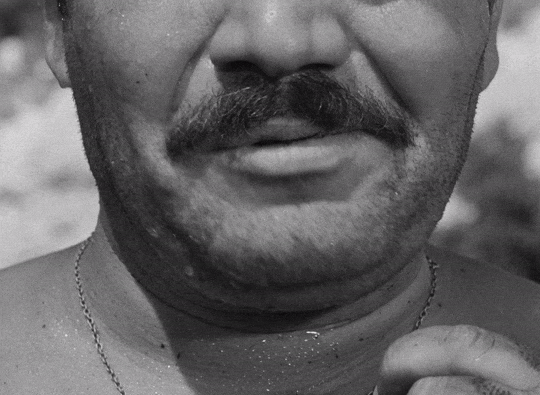
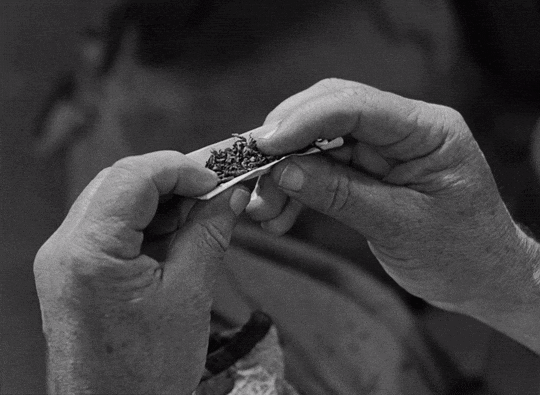
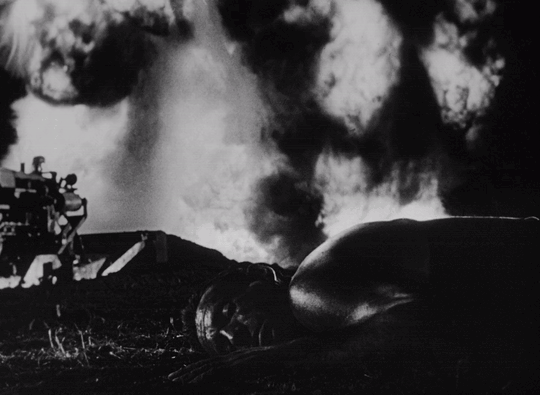
The Wages of Fear (1953)
----------------------------
dir. Henri-Georges Clouzot
cin. Armand Thirard
cs. France, Italy
#the wages of fear#le salaire de la peur#1953#1953 movies#henri georges clouzot#yves montand#charles vanel#folco lulli#armand thirard#french cinema#italian cinema#Véra Clouzot#Peter van Eyck
6 notes
·
View notes
Photo
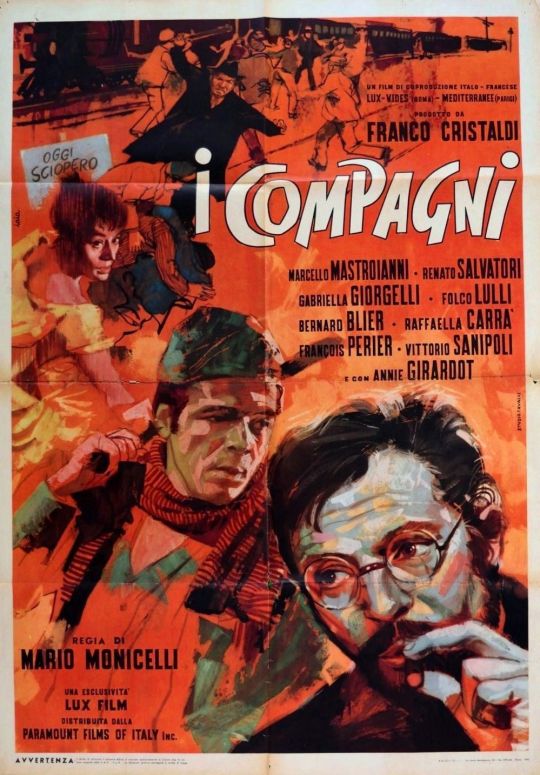
Mario Monicelli’s “I compagni” (The Organizer) October 25, 1963.
#Mario Monicelli#I compagni#The Organizer#1963#Sixties#Foreign#🇮🇹#Dramedy#Drama#Political#Labor#Marcello Mastroianni#Renato Salvatori#Annie Girardot#Folco Lulli#François Périer#Franco Ciolli#5/5
7 notes
·
View notes
Text





Mario Monicelli, I compagni (The organizer), 1963
#mario monicelli#i compagni#the organizer#marcello mastroianni#folco lulli#elvira tonelli#bernard blier#giampiero albertini#renato salvatori#cinema italiano#italian cinema
4 notes
·
View notes
Text
LIGHTNING BOLT '60s spy silliness - review and free on YouTube
‘Submit to the master or be quick-frozen forever in his cold-storage harem!’
Lightning Bolt is a 1967 action adventure with sci-fi elements involving space launches being sabotaged by a madman. It is highly derivative of the phenomenally popular James Bond movies.
Directed by Antonio Margheriti [as Anthony Dawson] (Killer Fish; Battle of the Worlds; Castle of Blood; Horror Castle) from a…
#1957#Anthony Eisley#Antonio Margheriti#Diana Lorys#Folco Lulli#free on YouTube#free online#James Bond rip-off#Lightning Bolt#review reviews#Wandisa Guida
0 notes
Text
23 maggio … ricordiamo …
23 maggio … ricordiamo …
#semprevivineiricordi #nomidaricordare #personaggiimportanti #perfettamentechic
2023: Domenico Minutoli, attore italiano. Conseguì gli studi di Maturità Artistica, lavorando fin da giovane come attore teatrale, televisivo e cinematografico. Inoltre, diresse alcuni spettacoli teatrali. (n.1947)
2017: Roger Moore, attore britannico, noto per la partecipazione alle serie televisive Ivanhoe (1958-1959), Il Santo (1962-1969) e Attenti a quei due (1971-1972), nonché per essere…

View On WordPress
#23 maggio#Anne Meara#Ansa Ikonen#Barbara Rudnik#Claudia Poggiani#Domenico Minutoli#Dorothy Gulliver#Dorothy Hyson#Dorothy Kathleen Gulliver#Dorothy Spencer#Dorothy Wardell Heisen#Folco Lulli#Gisella Monaldi#Giuditta Brozzetti#Giuditta Casini Brozzetti#Harry R. Townes#Harry Townes#Jean Yanne#Lady Quayle#Little Dot#Luisa Rossi#Mona Freeman#Monica Elizabeth Freeman#Morti 23 maggio#Myriam de Urquijo#Pilar Palacios de Urquijo#Roger Moore#Sterling Hayden#Umberto Bindi#Umberto Emilio Bindi
0 notes
Photo
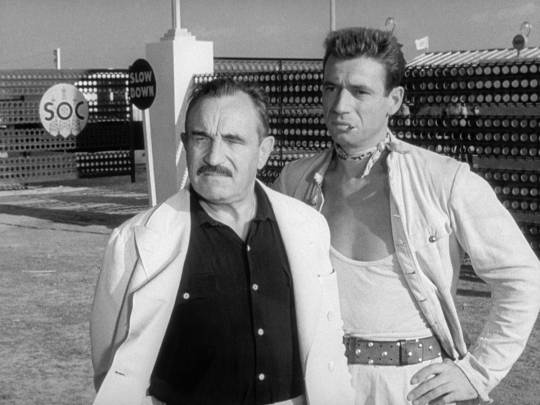
Charles Vanel and Yves Montand in The Wages of Fear (Henri-Georges Clouzot, 1953)
Cast: Yves Montand, Charles Vanel, Folco Lulli, Peter van Eyck, Véra Clouzot, William Tubbs, Jo Dest, Antonio Centa, Luis De Lima. Screenplay: Henri-Georges Clouzot, Jérôme Géronimi, based on a novel by Georges Arnaud. Cinematography: Armand Thirard. Art direction: René Renoux. Film editing: Madelein Gug, Etiennette Muse, Henri Rust. Music: Georges Auric.
With John Huston's The Treasure of the Sierra Madre (1948) and Sam Peckinpah's The Wild Bunch (1969), Henri-Georges Clouzot's The Wages of Fear forms an unholy trinity of adventure films. All three are about soldiers of fortune in Latin American countries seen as ripe for the pickings by predatory outsiders. Clouzot's film is probably the most deeply cynical of the three: Houston at least lets two of his adventurers survive, and Peckinpah's bunch at least shows some sympathy for the exploited poor. But from the opening of Clouzot's film, in which a half-naked child is seen tormenting some cockroaches (a scene Peckinpah borrowed for his film's opening), we are in hell. The unnamed country is being plundered by the Southern Oil Company, known by the acronym SOC, pronounced "soak." The S and the O, however, suggest Esso, the old trademark of Standard Oil before it and Mobil morphed into the double anonymity of Exxon. An oil well is on fire 300 miles away from the SOC headquarters, which lie on the outskirts of an impoverished village, and the easiest way to deal with the fire is to seal it off with explosives. So the foreman at the headquarters, Bill O'Brien (William Tubbs), proposes sending a couple of trucks cross-country, laden with nitroglycerin. Union drivers would balk at such dangerous work, so the company hires some of the local layabouts: Mario (Yves Montand), a swaggering Corsican; Jo (Charles Vanel), a French gangster from Paris; Luigi (Folco Lulli), an Italian who has just learned that he has a terminal lung illness from his work handling cement for SOC; and Bimba (Peter van Eyck), a German who survived forced labor in a salt mine under the Nazis. All have been idling in the village waiting for the big break that will allow them to leave, and this seems to be it. Desperation at getting out is so intense that one of the men who vie for the job commits suicide after he fails to land it. The journey is, to say the least, harrowing, and Clouzot makes the most of every nail-biting moment of it. As a director, hes as smart in what he chooses not to show us and in what he does. Jo, for example, is not the first choice as a driver: O'Brien goes with a younger man. But when that man doesn't show up on the morning of departure, Jo takes his place. We don't see what Jo did to eliminate or delay his rival, but we're sure it wasn't good. And when one of the trucks explodes, we don't see the buildup to or the cause of the explosion: We witness it from a distance, and then join the surviving truck drivers as they come upon the scene, which they treat as just another hazardous obstacle on the road. The Wages of Fear was heavily cut on its first American release: The portrayal of American capitalism didn't sit well in the era of HUAC investigations. Clouzot's nihilism in The Wages of Fear sometimes feels a little heavy: One character actually dies with the word "nothing" on his lips. The screenplay for The Wages of Fear lacks the polished wit of The Treasure of the Sierra Madre, which also contains the great performances of Humphrey Bogart, Walter Huston, and the undervalued Tim Holt. And The Wild Bunch displays Peckinpah's great narrative drive and unequaled handling of action sequences. But Clouzot's film easily belongs in their company, and its uncompromising darkness makes many think it the best of the three.
2 notes
·
View notes
Text
Fatalismo amargo (1097)

El premiado escritor y poeta vallisoletano Eduardo Roldán nos habla en su columna del periódico vallisoletano, EL Norte de Castilla, "La sombra del ciprés el 20/04/2024" sobre la película franco-italiana EL SALARIO DEL MIEDO de 1953.

El salario del miedo es una película coproducción franco-italiana de 1953, del género dramático y aventuras, dirigida por Henri-Georges Clouzot. La película está basada en la novela homónima escrita por Georges Arnaud en 1950. Fue elegida como el top 06 de las 100 mejores películas de acción de todos los tiempos por GQ en 2020. Wikipedia
Escribe Eduardo Roldán en su articulo:

Escuchar y / o leer...
1097-1
LA PELICULA ...
1097-2 https://ok.ru/video/6944108120805
En 1977 se produje una nueve version (remake),

Sorcerer (en español Carga maldita o El salario del miedo) es una película estadounidense de suspenso de 1977, producida y dirigida por William Friedkin y basada en la novela El salario del miedo (Le Salaire de la peur), de Georges Arnaud.
Se trata de una nueva versión de la cinta El salario del miedo, dirigida por Henri-Georges Clouzot en 1953. Wikipedia.
LA PELICULA ...
1097-3 https://ok.ru/video/3455333108456
Notas:
Fatalismo Amargo de Eduardo Roldán
Ha pasado una hora y los protagonistas de El salario del miedo siguen más o menos donde estaban al comienzo, y el espectador principia a preguntarse si la sinopsis no se habrá confundido al calificar al film de suspense. No lo ha hecho, o solo en parte; es un film de suspense, pero también un melodrama, un drama de denuncia social, incluso un film de terror (en la escena de la piscina de petróleo). El suspense, con todo, comenzará en este momento y se extenderá durante la hora y media restante.
Así, El salario… se articula en dos segmentos bien definidos. El primer segmento es una suerte de Los inútiles de Fellini (también del año 53), pero con una existencia más precaria, social y laboral. En esta primera parte se presentan a los personajes fundamentales y se dan a conocer los distintos motivos que los han llevado al enclave —ficticio— de Las Piedras, un pequeño y empobrecido pueblo perdido en algún lugar de Centroamérica donde el capital americano hace y deshace a su antojo, única vía no obstante para sacarse unos cuartos, aun escasos, y tratar de conseguir un billete de avión y escapar, objetivo compartido por todos. Los cuatro protagonistas son Mario (Yves Montand), Jo (Charles Vanel), Luigi (Folco Lulli) y Bimba (Peter Van Eyck), a los que hay que añadir a Linda (Véra Clouzot), amante ciega del primero pese al trato que recibe. La vida, pues, va pasando, se cruzan historias sin grandes escándalos, y ellos la toman con un fatalismo resignado, ni siquiera con resquemor hacia la compañía petrolera; sencillamente las cosas son así, unos están arriba y otros están abajo, y cada cual trata de sacar el mayor partido posible, no hay más vueltas que darle.
Un accidente en forma de fuego desatado en uno de las plantas de extracción de la compañía, a 500 kms. de Las Piedras, hará que este fatalismo estático se sustituya por uno dinámico y el suspense comience a rodar. La única manera de extinguir el caos es con nitroglicerina (creando una explosión que tape el pozo de petróleo incendiado), y esta ha de ser llevada hasta la planta del desastre en dos camiones precarios, sin ningún tipo de seguridad. ¿A quién podría interesarle un trabajo así? Pues a todo el mundo: no hay varón en Las Piedras que no se haga pasar por conductor, y es que el salario por llevar la nitroglicerina excede con mucho el de sus fantasías: 2.000 dólares, más que suficiente para salir de allí de una vez por todas y comenzar una nueva vida. (Este es, pues, el precio en que cifran sus vidas, en un caso literalmente: hay un joven que se suicida por no lograr entrar en la cuadrilla). De la fibra moral de la compañía petrolera da cuenta la razón por la que, más allá de la destreza al volante, Mario, Jo, Luigi y Bimba son elegidos: por ser unos tirados, o sea que no pertenecen a ningún sindicato ni tienen familia, de modo que si les ocurriera algo nadie iría a reclamar nada a la empresa, nadie montaría un tumulto.
Este segundo segmento, con el traslado de la nitroglicerina, es donde se desarrolla el suspense en sentido clásico, en cuatro piezas independientes (cuatro obstáculos en el camino que los camiones, conducidos por Mario y Jo y por Luigi y Bimba, han de superar). El suspense, y esto va con el género, no radica tanto en saber si superarán el obstáculo o no, al menos al principio, pues si no lo superasen, se terminaría la película. No, el interés está en el cómo. Y es en el cómo donde el magisterio de Clouzot brilla en su máxima expresión.
Clouzot adopta un punto de vista casi documental —recuerda al Bresson de Un condenado a muerte se ha escapado, solo que esta es posterior y formalmente aun más severa—, una mirada esencialmente neutra, pero que tampoco cabe calificar de objetiva: ya la selección de las imágenes, del encuadre, del tiempo de cada una condiciona la experiencia del espectador (como muy bien ha dicho y viene demostrando desde hace medio siglo el gran Frederick Wiseman). <<A veces una hora se hace muy larga>>, dice Bimba en cierto momento, y es lo que hace Clouzot en las piezas de suspense: estirar la tensión, adensarla, dilatar el presente, avertigarlo, en un manejo del tiempo que es el mayor logro del film.
Que tiene en el retrato moral el otro gran logro. No se trata de mostrar a héroes, no hay heroísmo en la decisión de emprender el trayecto, son solo unos tipos que intentan salvar su culo de la única forma que se les presenta, y si esta supone llevar a cabo acciones arriesgadas, tal no las convierte en heroicas. El poso que deja El salario… es el de un fatalismo amargo, de una ironía trágica, que el final no hace sino subrayar.
(La sombra del ciprés, 20/04/2024)
@enfaserem
Ficha del film
Tít: El salario del miedo
Dir: Henri-Georges Clouzot
Ints.: Yves Montand, Charles Vanel, Folco Lulli, Peter Van Eyck, Véra Clouzot
Francia e Italia, drama, blanco y negro, 153 mins.
TEMAS
cine, drama, el salario del miedo, henri-georges clouzot
1 note
·
View note
Text
A great French restaurant’s owner, Monsieur Septime, is thrust into intrigue and crime, when one of his famous guests disappears.

Credits: TheMovieDb.
Film Cast:
M. Septime, patron d’un grand restaurant parisien: Louis de Funès
Le commissaire divisionnaire: Bernard Blier
Sophia, la secrétaire du président Novalès: María Rosa Rodríguez
Henrique, chef de la sécurité du président Novalès: Venantino Venantini
Le président sud-américain Novalès: Folco Lulli
Le sommelier buveur: Paul Préboist
Le ministre: Noël Roquevert
Henri: Yves Arcanel
Le conspirateur français: Robert Dalban
Le général conspirateur: Julián Antonio Ramírez
Le complice de Novalès: Eugene Deckers
Un conspirateur: Frédéric Santaya
Un conspirateur: Albert Dagnant
Le maître d’hôtel « Mon Dieu ! Mon Dieu ! »: Jean Ozenne
Le second maître d’hôtel: Pierre Tornade
Le troisième maître d’hôtel: Yves Elliot
Petit-Roger, le serveur lèche-bottes: Michel Modo
Un serveur: Jacques Dynam
Un serveur: Guy Grosso
Un serveur: Jean Droze
Un serveur: Pierre Roussel
Un serveur: René Bouloc
Julien, un serveur et violoncelliste forcé: Maurice Risch
Marcel, le chef cuisinier: Raoul Delfosse
Marmiton Louis, le filleul de Marcel, le chef cuisinier: Olivier de Funès
Le violoniste / Client qui dit que “ce n’est pas cher du tout”: Max Montavon
Le Doktor Müller ” Kartoffeln und Muskatnuss “: Claus Holm
L’invité ignoré du ministre: André Badin
Un client du restaurant: Marc Arian
Le pianiste: Roger Caccia
Le second inspecteur adjoint: Henri Marteau
L’agent de police: Jacques Legras
…: René Berthier
Le client satisfait: Bernard Dumaine
Un client du restaurant: Roger Lumont
Le client taché: Paul Faivre
…: Julian Ramirez
Le baron: Robert Destain
La baronne: France Rumilly
Film Crew:
Writer: Louis de Funès
Writer: Jean Halain
Writer: Jacques Besnard
Movie Reviews:

View On WordPress
#1960s#alpes#car accident#chef#expensive restaurant#flambé#france#kidnapping#latin american revolution#national anthem#Paris#police commissioner#president#restaurant#restaurant owner#suspected#terrorism#Top Rated Movies#wig
0 notes
Video
youtube
LA GRANDE GUERRA (1959) - Trailer | Filmauro
LA GRANDE GUERRA - 15- 18
AGE E SCARPELLI - SCENEGGIATORI
Figlio di Poseidone e di Libia e fratello di Belo[2][3], sposò Telefassa[2] (che Igino chiama Argiope[4]) che lo rese padre di Cadmo, Cilice, Fenice ed una sola figlia, Europa[2].
Tra i figli, Pausania aggiunge Taso[5].
Mitologia
Sua figlia Europa era bellissima, Zeus volle possederla e per questo si celò sotto le sembianze di un toro e la rapì.
Agenore inviò i suoi figli nella sua ricerca[2][5] dicendogli di non tornare senza di lei. Nel corso delle loro peregrinazioni, questi figli fondarono città ovunque e così Fenice divenne il capostipite dei fenici, Cilice quello dei cilici, Cadmo si stabilì in Beozia costruendo Cadmea, la rocca di Tebe. Nessuno di loro però trovò Europa[2].
La stirpe
La grande guerra è una commedia drammatica del 1959 diretta da Mario Monicelli, prodotta da Dino De Laurentiis e interpretata da Alberto Sordi e Vittorio Gassman.
Mario Monicelli, Age & Scarpelli, Luciano Vincenzoni
Produttore Dino De Laurentiis
Fotografia Leonida Barboni, Roberto Gerardi, Giuseppe Rotunno, Giuseppe Serrandi
Montaggio Adriana Novelli
Effetti speciali Gatti, Serse Urbisaglia
Musiche Nino Rota
Scenografia Mario Garbuglia
Costumi Danilo Donati
Trucco Romolo De Martino, Rino Carboni
Interpreti e personaggi
Alberto Sordi: Oreste Jacovacci
Vittorio Gassman: Giovanni Busacca
Silvana Mangano: Costantina
Romolo Valli: tenente Gallina
Folco Lulli: Giuseppe Bordin
Bernard Blier: capitano Castelli
Vittorio Sanipoli: maggiore Segre
Nicola Arigliano: Giardino
Geronimo Meynier: portaordini
Mario Valdemarin: sottotenente Loquenzi
Elsa Vazzoler: moglie di Bordin
Tiberio Murgia: Rosario Nicotra
Livio Lorenzon: sergente Battiferri
Ferruccio Amendola: De Concini
Gianni Baghino: un soldato
Carlo D'Angelo: capitano Ferri
Achille Compagnoni: cappellano
Luigi Fainelli: Giacomazzi
Marcello Giorda: il generale
Tiberio Mitri: Mandich
Gérard Herter: capitano austriaco
Guido Celano: maggiore italiano
Leandro Punturi: bambino
Mario Feliciani
Mario Mazza
Mario Colli
Mario Frera
Gian Luigi Polidoro: attendente del capitano austriaco
Edda Ferronao
Doppiatori originali
Nino Dal Fabbro: capitano Castelli
Mario Colli: cappellano
Turi Ferro: Rosario Nicotra
Riccardo Cucciolla: Giardino
Gastone Moschin: sergente Battiferri
❤️❤️❤️❤️❤️❤️❤️❤️❤️❤️❤️❤️❤️❤️❤️❤️❤️❤️❤️❤️ ❤️❤️
#gustavopetro
#colombia
#DONALDTRUMP
#TRUMP
#BOLSONARO
#DORIGHEZZI
#STRISCIALANOTIZIA
#FRANCESCO
#RUTELLI
#PROPAGANDALIVE
#ELUANA
#ENGLARO
#ELUANAENGLARO
#CRISTIANODEANDRE
#twitter
#facebook
#skyrock
#linkedin
#instagram
#okru
#tiktok
0 notes
Text









"The Wages of Fear" (1953)
#henri georges clouzot#the wages of fear#yves montand#charles vanel#vera clouzot#folco lulli#peter van eyck#darling legitimus#movie poster
26 notes
·
View notes
Photo

l’armata brancaleone (1966)
#mario monicelli#vittorio gassman#folco lulli#catherine spaak#gian maria volontè#carlo pisacane#maria grazia buccella#barbara steele
4 notes
·
View notes
Photo








The Wages of Fear (Le Salaire de la peur) (1953) Henri-Georges Clouzot
May 29th 2021
#the wages of fear#le salaire de la peur#1953#henri-georges clouzot#yves montand#charles vanel#folco lulli#peter van eyck#vera clouzot#william tubbs
10 notes
·
View notes
Photo










Films watched in 2020.
193: Le salaire de la peur (H.G. Clouzot, 1953)
★★★★★★★★☆☆
“You don't know what fear is. But you'll see.“
#films watched in 2020#Le salaire de la peur#H.G. Clouzot#clouzot#ocho#Henri-Georges Clouzot#henri georges clouzot#black and white#Yves Montand#Charles Vanel#Folco Lulli#Véra Clouzot#the wages of fear#cult#thriller#adventure#drama#poverty#cars#back#money#quote#fear
95 notes
·
View notes
Text





«Your stomachs will stay empty, and your children's too, if you give up this fight now! The bosses will always win, and your misery will continue to enrich them!»
«It's not our factory!»
«Not yours? Who works there 14 hours a day their whole life? Whose sweat keeps the machines going? Then take it! The factory is yours! Show them it means more to you than your own homes! Make the bosses, the city, and the government see that it's your life and death!»
Mario Monicelli, I compagni (The organizer), 1963
#mario monicelli#i compagni#the organizer#marcello mastroianni#folco lulli#elvira tonelli#bernard blier#giampiero albertini#renato salvatori#cinema italiano#italian cinema
3 notes
·
View notes